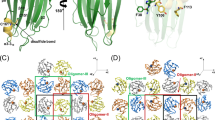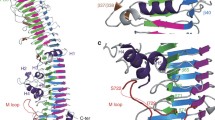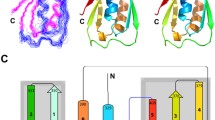Abstract
Coexpression of pairs of nonhaemolytic H1yA mutants in the recombination-deficient (recA) strain Escherichia coli HB101 resulted in a partial reconstitution of haemolytic activity, indicating that the mutation in one H1yA molecule can be complemented by the corresponding wild-type sequence in the other mutant HlyA molecule and vice versa. This suggests that two or more HlyA molecules aggregate prior to pore formation. Partial reconstitution of the haemolytic activity was obtained by the combined expression of a nonhaemolytic HlyA derivative containing a deletion of five repeat units in the repeat domain and several nonhaemolytic HlyA mutants affected in the pore-forming hydrophobic region. The simultaneous expression of two inactive mutant HlyA proteins affected in the region at which HlyA is covalently modified by HlyC and the repeat domain, respectively, resulted in a haemolytic phenotype on blood agar plates comparable to that of wild-type haemolysin. However, complementation was not possible between pairs of HlyA molecules containing site-directed mutations in the hydrophobic region and the modification region, respectively. In addition, no complementation was observed between HlyA mutants with specific mutations at different sites of the same functional domain, i.e. within the hydrophobic region, the modification region or the repeat domain. The aggregation of the HlyA molecules appears to take place after secretion, since no extracellular haemolytic activity was detected when a truncated but active HlyA lacking the C-terminal secretion sequence was expressed together with a non-haemolytic but transport-competent HlyA mutant containing a deletion in the repeat domain.
Similar content being viewed by others
References
Baumann A, Grupe A, Ackermann A, Pongs O (1988) Structure of the voltage-dependent potassium channel is highly conserved from Drosophila to vertebrate central nervous system. EMBO J 7:2457–2463
Benz R, Schmid A, Wagner W, Goebel W (1989) Pore formation by the Escherichia coli hemolysin: evidence for an association-dissociation equilibrium of the pore-forming aggregates. Infect Immun 57:887–895
Benz R, Döbereiner A, Ludwig A, Goebel W (1992) Haemolysin of Escherichia coli: Comparison of pore-forming properties between chromosomal and plasmid-encoded haemolysins. FEMS Microbiol Immunol 105:55–62
Bhakdi S, Mackman N, Nicaud J-M, Holland IB (1986) Escherichia coli hemolysin may damage target cell membranes by generating transmembrane pores. Infect Immun 52:63–69
Boehm DF, Welch RA, Snyder IS (1990) Domains of Escherichia coli hemolysin (HlyA) involved in binding of calcium and erythrocyte membranes. Infect Immun 58:1959–1964
Felmlee T, Pellett S, Welch RA (1985) Nucleotide sequence of an Escherichia coli chromosomal hemolysin. J Bacteriol 163:94–105
Fox RO Jr, Richards FM (1982) A voltage-gated ion channel model interferred from the crystal structure of alamethicin at 1.5—Å resolution. Nature 300:325–330
Gentschev I, Goebel W (1992) Topological and functional studies on HlyB of Escherichia coli. Mol Gen Genet 232:40–48
Goebel W, Hedgpeth J (1982) Cloning and functional characterization of the plasmid-encoded hemolysin determinant of Escherichia coli. J Bacteriol 151:1290–1298
Guy HR, Hucho F (1987) The ion channel of the nicotinic acetylcholine receptor. TrendsNeurosci 10:318–321
Hanke W, Methfessel C, Wilmsen H-U, Katz E, Jung G, Boheim G (1983) Melittin and a chemically modified trichotoxin form alamethicin-type multi-state pores. Biochim Biophys Acta 727:108–114
Hess J, Wels W, Vogel M, Goebel W (1986) Nucleotide sequence of a plasmid-encoded hemolysin determinant and its comparison with a corresponding chromosomal hemolysin sequence. FEMS Microbiol Lett 34:1–11
Issartel J-P, Koronakis V, Hughes C (1991) Activation of Escherichia coli prohaemolysin to the mature toxin by acyl carrier proteindependent fatty acylation. Nature 351:759–761
Laemmli UK (1970) Cleavage of structural proteins during the assembly of the head of bacteriophage T4. Nature 227:680–685
Ludwig A, Goebel W (1991) Genetic determinants of cytolytic toxins from Gram-negative bacteria. In: Alouf JE, Freer JH (eds) Sourcebook of bacterial protein toxins. Academic Press, London, pp 117–146
Ludwig A, Vogel M, Goebel W (1987) Mutations affecting activity and transport of haemolysin in Escherichia coli. Mol Gen Genet 206:238–245
Ludwig A, Jarchau T, Benz R, Goebel W (1988) The repeat domain of Escherichia coli haemolysin (HlyA) is responsible for its Ca2+-dependent binding to erythrocytes. Mol Gen Genet 214:553–561
Ludwig A, Schmid A, Benz R, Goebel W (1991) Mutations affecting pore formation by haemolysin from Escherichia coli. Mol Gen Genet 226:198–208
Ludwig A, Garcia F, Benz R, Jarchau T, Oropeza-Wekerle RL, Hoppe J, Goebel W (1992) Structures essential for pore formation by Escherichia coli haemolysin. In: Witholt B et al. (eds) Bacterial protein toxins, Zbl Bakt Suppl 23. Gustav Fischer-Verlag, Stuttgart, Jena, New York, pp 450–460
Mackman N, Baker K, Gray L, Haigh R, Nicaud J-M, Holland IB (1987) Release of a chimeric protein into the medium from Escherichia coli using the C-terminal secretion signal of haemolysin. EMBO J 6:2835–2841
Oiki S, Danho W, Madison V, Mental M (1988) M2δ, a candidate for the structure lining the ionic channel of the nicotinic cholinergic receptor. Proc Natl Acad Sci USA 85:8703–8707
Schülein R, Gentschev I, Mollenkopf H-J, Goebel W (1992) A topological model for the haemolysin translocator protein HlyD. Mol Gen Genet 234:155–163
Sherman F, Fink G, Hicks T (1983) Methods in yeast genetics. Cold Spring Harbor Laboratory Press. Cold Spring Harbor, New York
Towbin H, Staehelin T, Gordon J (1979) Electrophoretic transfer of proteins from polyacrylamide gels to nitrocellulose sheets: Procedure and some applications. Proc Natl acad Sci USA 76:4350–4354
Wagner W, Vogel M, Goebel W (1983) Transport of hemolysin across the outer membrane of Escherichia coli requires two functions. J Bacteriol 154:200–210
Wandersman C, Delepelaire P (1990) TolC, an Escherichia coli outer membrane protein required for hemolysin secretion. Proc Natl Acad Sci USA 87:4776–4780
Author information
Authors and Affiliations
Additional information
Communicated by E. Bautz
Rights and permissions
About this article
Cite this article
Ludwig, A., Benz, R. & Goebel, W. Oligomerization of Escherichia coli haemolysin (HlyA) is involved in pore formation. Molec. Gen. Genet. 241, 89–96 (1993). https://doi.org/10.1007/BF00280205
Received:
Accepted:
Issue Date:
DOI: https://doi.org/10.1007/BF00280205




